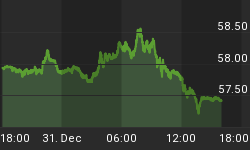The stock market, the bond market, the commodities markets (to a lesser extent), FX markets - they are all experiencing a marked increase in volatility.
Some observers want to call this bearish for equities, mainly because they already are bearish. This is a very bad reason. While really bad equity returns almost always occur coincident with a rise in volatility - the old maxim is that stocks go 'up on the staircase and down on the escalator' - that does not mean that volatility causes bad returns. Or, put another way, there are also periods of increased volatility that do not precede and are not coincident with bad returns.
However, there actually is a reason that increased volatility might lead to poor short- to medium-term returns, that isn't based on technical analysis or spurious correlations. Moreover, a relatively new phenomenon (the rise of so-called 'risk-parity' strategies) is starting to institutionalize what was already a somewhat natural response to volatility.
In 'risk-parity' strategies, the weight of an asset class (or a security within an asset class, sometimes) is inversely proportional to the risk it adds to the portfolio. Generally speaking, "risk" here is defined as variance, because it is easy to estimate and there are markets where symmetrical variance trades - i.e., options markets. But what this means is that when volatility (sometimes realized volatility, and sometimes option "implied" volatility) rises in stocks, then risk parity strategies tend to be shedding equities because they look riskier, and vice-versa. Right now, risk parity strategies are likely to be overweight equities because of the long period of low realized and implied volatility (even though the valuation measures imply quite high risk in the sense most of us mean it, in terms of the probability of return shortfall). Risk parity strategies are probably superior to 'return-chasing' methodologies, but by being 'risk-chasing' they end up doing something fairly similar when they are all operating together.
Note that while risk-parity strategies are comparatively new - well, not exactly because it is an oldish idea, but they have only recently become a big fad - this general phenomenon is not. The natural response to greater equity market volatility is to pare back exposure; when your broker statement starts to swing around wildly it makes you nervous and so you may start to take some profits. This is also true of other asset classes but it seems to me to be especially true in equities. Nobody who gets involved in commodities is surprised at volatility: the asset class suffers from a midguided belief that it is terribly volatile even though commodity indices are just about exactly as volatile as equity indices over time. But equity investors, contrariwise, seem perennially surprised at 2% moves.
So, while the recent volatility doesn't mean that a move lower in equities is assured, it increases the probability of such because risk-parity strategies (and other investors reacting nervously to overweights in their equity exposure) will begin to scale back positions in the asset class in favor of positions in other asset classes, probably mostly bonds and commodities. At this point it would be good for me to point out that only the very short-term volatility measures have moved up dramatically; the VIX is well off its bottom but only up to 18.8 and it has been there numerous times in the last few years (see chart, source Bloomberg). But the longer the volatility continues like we have seen it for the last week or two, the bigger the chances that the asset-allocation boxes start to make important shifts (and the quant hedge fund boxes will probably move a bit before those asset allocation boxes do).
As an aside, the tendency for asset allocation shifts to follow volatility shifts is not the reason that the VIX displays a strong inverse directionality. Neither is the main reason for this inverse directionality because the VIX is a "fear gauge." The main reason is that the VIX weights near-the-money options more heavily than out-of-the-money options. Because options skews almost always imply more downside volatility for stocks than upside volatility[¹], when the market declines it tends to bring more "high volatility" strikes into play and so part of the VIX increase in a down market is simply mechanical.
I am not calling for a sharp decline in stocks, nor for an extended decline in stocks. My position and view is as it has long been, that the prospect for attractive real returns from equities over the next 5-10 years is quite small and beaten handily by commodities' prospective returns at that end of the risk spectrum. I don't think that most investors (me included!) should swing asset allocations around frequently in response to technical indicators or such things as "momentum", but rather should focus on evaluating expected long-term returns (which are somewhat predictable) and invest for value. And I must admit I also think that "risk-parity" is a clever marketing gimmick but a pretty absurd way to assemble a portfolio for almost everyone. My point here is to highlight one little-considered aspect of herd behavior, and how that herd behavior may have become more institutionalized as late, and to consider the risks that herd behavior may create.
[¹] This in turn is not due so much from the tendency of markets to have more downside volatility than upside volatility, but from the fact that buying protective puts and selling "covered" calls are both considered "conservative" options strategies. So, out-of-the-money puts tend to be too expensive and out-of-the-money calls too rich.
You can follow me @inflation_guy!
Enduring Investments is a registered investment adviser that specializes in solving inflation-related problems. Fill out the contact form at http://www.EnduringInvestments.com/contact and we will send you our latest Quarterly Inflation Outlook. And if you make sure to put your physical mailing address in the "comment" section of the contact form, we will also send you a copy of Michael Ashton's book "Maestro, My Ass!"

















